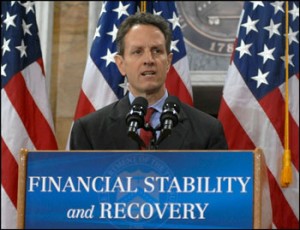
U.S. Treasury Sec. Tim Geithner will be on hand when CEO Sergio Marchionne is expected to announce plans to pay off Chrysler's government loans.
This story has been updated to reflect Chrysler’s official confirmation it will pay off its federal loans.
Treasury Sec. Timothy Geithner will take a tour of Chrysler’s Jefferson North Plant today, but it will be more than just a friendly visit, the automaker today announcing it plans to pay back its remaining federal bailout loans by the end of June.
Sergio Marchionne, CEO of both Chrysler and its Italian ally Fiat, has been lining up alternative – and less expensive funding – in recent weeks. With Geithner at his side during the visit to the Detroit plant, Marchionne is expected to provide further details about the plan to repay $5.8 billion to the U.S. Treasury and another $1.7 billion to the Canadian government.
The move will permit the Italian side of the alliance to increase its stake in Chrysler to 46%. Marchionne has already indicated he expected to meet a final hurdle set under the bailout that would permit Fiat to bump its holdings to a majority 51% by the end of this year.
It’s likely Geithner will at least touch on the early payoff of Chrysler’s bailout during a Thursday afternoon speech to the Detroit Economic Club – though the overall economy was planned to be his primary topic. The improving fortunes of Detroit’s Big Three has helped the Obama Administration quell early criticism of the costly bailouts of Chrysler and General Motors.
Ford – the only domestic automaker not to require a bailout – reported an unexpectedly strong $2.6 billion profit for the first quarter, about 20% better than what a consensus of Wall Street analysts had forecast. General Motors is also forecast to be solidly in the black for the quarter.
Chrysler, which has not yet returned to public trading is nonetheless planning to report what Marchionne has hinted will be its first profit since emerging from bankruptcy in May 2009. Fiat was given a 20% stake in the U.S. maker at that time as part of the bailout.
Since then, Fiat has met two initial hurdles set under the government rescue plan, introducing a new, high-mileage engine and increasing Chrysler’s global business. Each of those garnered the Italians an additional 5% stake.
By paying off the government Fiat would be able to add another 16% to bring its stake to 46%. The price tag for the additional stake is currently $1.27 billion. That figure might have actually risen had Fiat waited until after a positive earnings report as the stronger Chrysler becomes the more the government was going to charge.
The final goal – which could push Fiat’s stake to 51% — requires introducing a 40 mpg vehicle to the U.S. market. That is expected before year-end, according to earlier statements by the Fiat/Chrysler CEO.
In the end, Fiat will have paid just $1.27 billion and the interest on the federal loans to acquire a controlling stake. A bargain for a healthy company, Marchionne last week asserted that it was a fair deal considering few expected Chrysler to survive even with a federal bailout.
“It’s a pricing mechanism that, I think, reflected the conditions of the entities at the time, in 2009,” he said during a meeting in Turin, where Fiat is headquartered.
Marchionne has yet to set a formal date for staging the much-anticipated IPO which would mark Chrysler’s return to public trading. He has indicated that he would like to stage the offering late this year but recently suggested it might be pushed back to sometime in 2012. A decision would have to be approved not only by the Chrysler board but also by United Auto Workers Union health care trust that currently holds the majority stake in the U.S. automaker.
